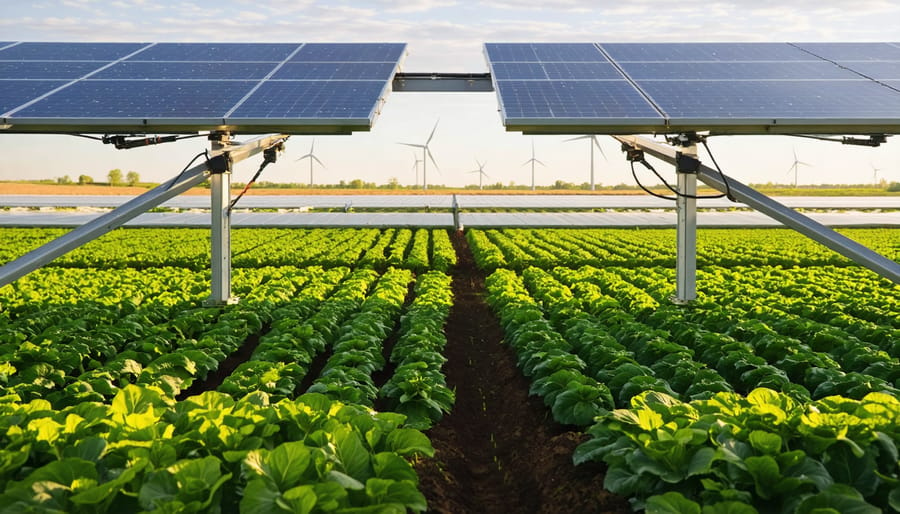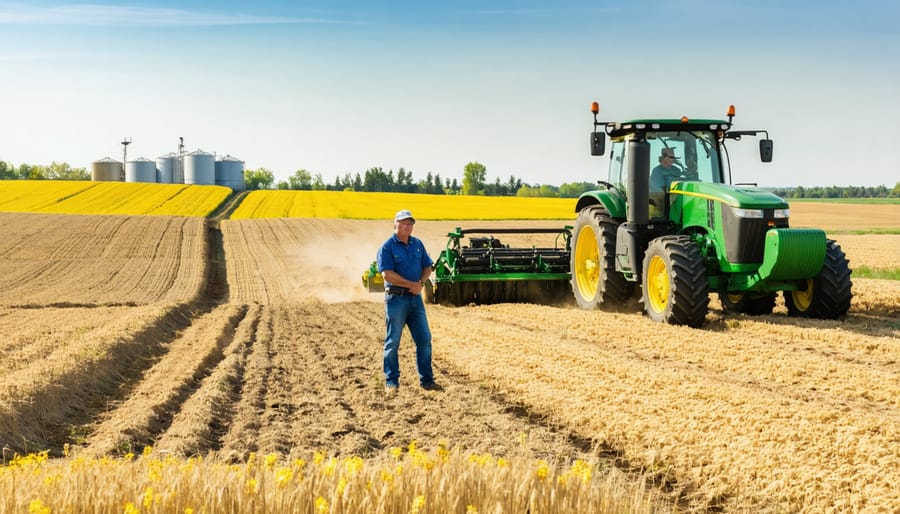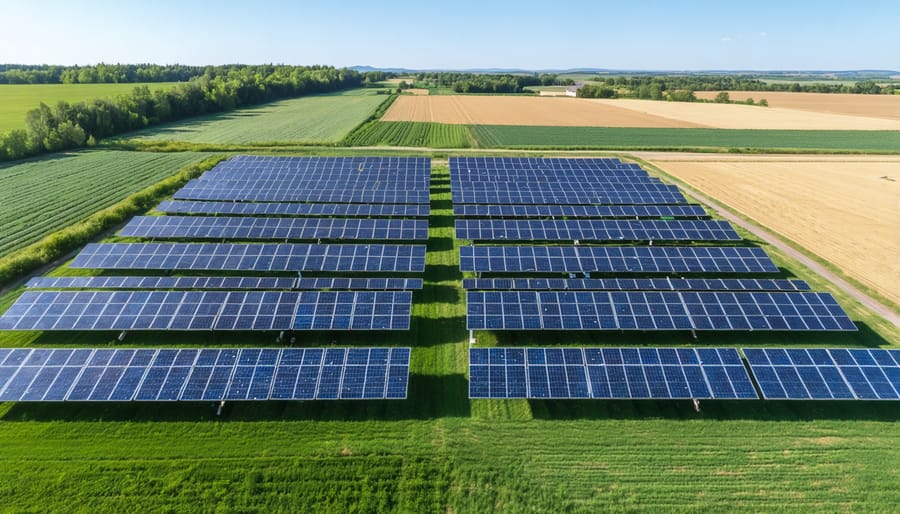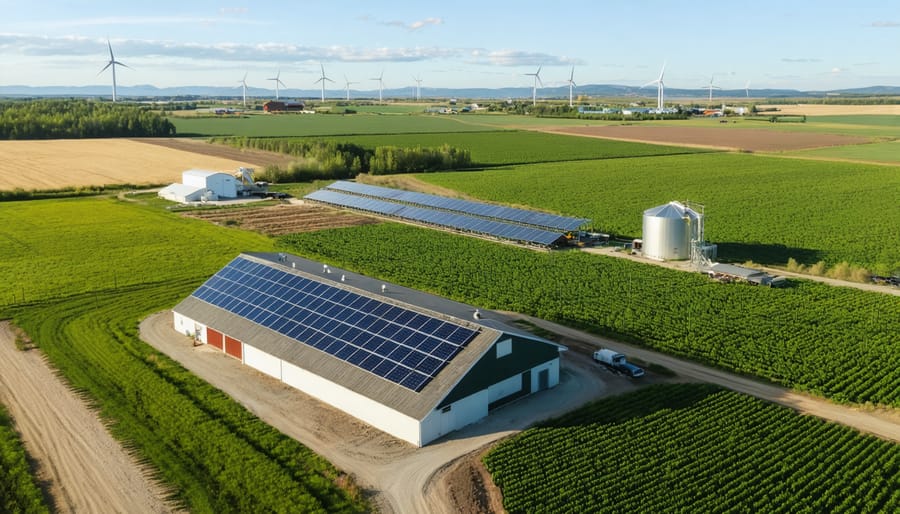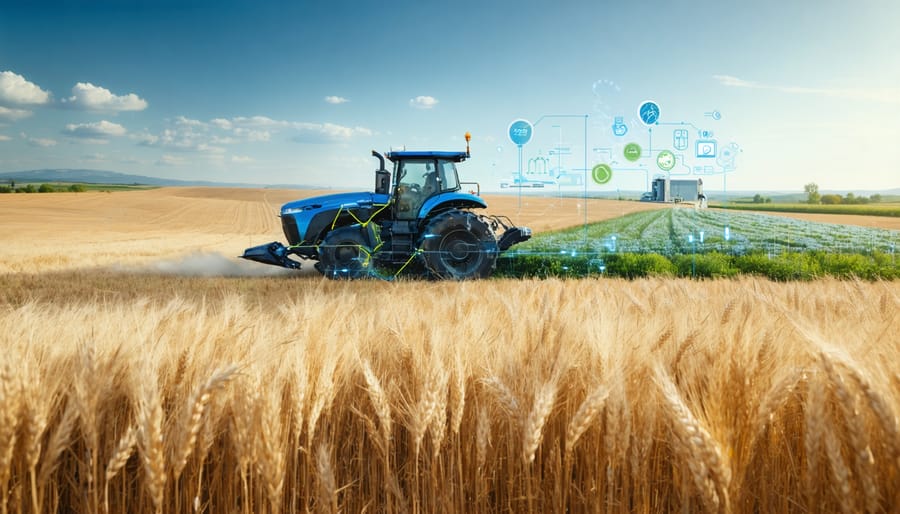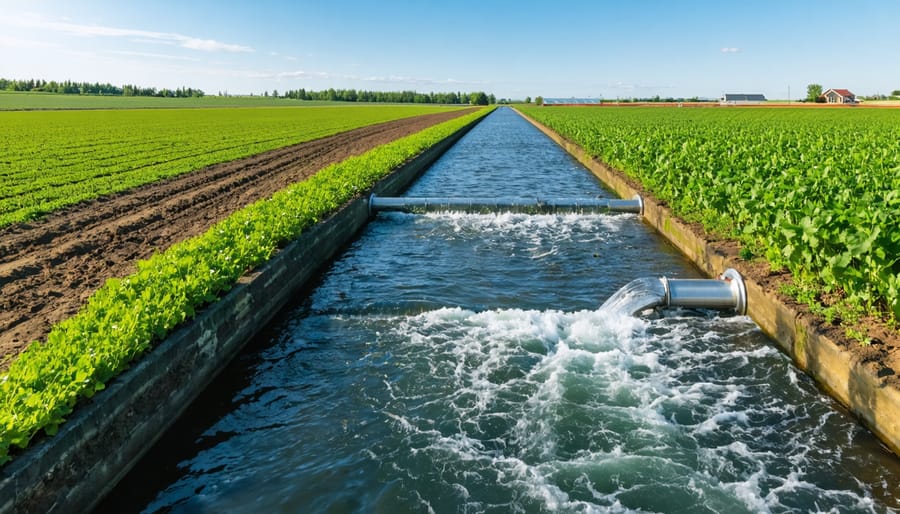Your diesel bill tells a story about carbon, and it’s time to rewrite that narrative. Zero carbon fuels—renewable energy sources that emit no net carbon dioxide when produced and used—offer Alberta farmers a genuine pathway to slash operational emissions while maintaining the power demands of modern agriculture. Biogas from livestock manure, renewable diesel from canola oil, and hydrogen from wind-powered electrolysis aren’t science fiction; they’re working solutions on Canadian farms today.
The economics are shifting rapidly. What once seemed like environmental idealism now makes hard-nosed business sense as carbon pricing expands, fuel costs fluctuate unpredictably, and early adopters discover revenue streams from waste products that previously cost money to manage. Saskatchewan farmer Jim Halford converted his operation’s manure into enough biogas to power his entire grain drying system, cutting his natural gas bill by 70 percent while reducing methane emissions from his feedlot.
Understanding which zero carbon fuel fits your operation requires matching fuel characteristics to your specific equipment, climate conditions, and crop or livestock systems. A dairy farm with consistent manure supply faces different opportunities than a grain operation with seasonal power demands. The technology exists, government support programs are active, and the knowledge base from peer farmers continues to expand. Your transition doesn’t require revolutionary changes overnight—it starts with evaluating one piece of equipment, one fuel source, and one practical step toward energy independence and carbon neutrality.
What Zero Carbon Fuels Actually Mean for Your Farm

The Carbon Balance You Need to Understand
Think of your farm’s carbon footprint like a bank account. Traditional diesel or gasoline puts carbon into the atmosphere without taking any out—that’s a withdrawal with no deposits. Zero carbon fuels work differently because they balance the books.
Here’s how it works in practice: When you grow canola or other energy crops, those plants pull carbon dioxide from the air as they grow. When processed into biodiesel and burned in your equipment, they release roughly the same amount back. The carbon cycles through—it’s borrowed and returned, not added. Similarly, hydrogen fuel produced using solar or wind power emits only water vapour when used, with no fossil carbon entering the cycle.
Saskatchewan farmer Tom Mitchell explains it simply: “We’re essentially using sunshine from this year instead of sunshine stored in the ground for millions of years.” That’s the fundamental difference.
The key is the production method. Renewable energy sources—whether it’s wind turbines in southern Alberta or solar panels on your barn—power the fuel creation process without generating new emissions. This creates a closed loop where carbon in equals carbon out, achieving that crucial net-zero balance your operation needs for true sustainability.
Why This Matters for Alberta Agriculture
Alberta’s agricultural sector faces unique pressures and opportunities when it comes to zero carbon fuels. Our province has committed to achieving net-zero emissions by 2050, and agriculture plays a significant role in reaching this target. With fuel costs representing up to 15% of total operating expenses for many grain and livestock operations, exploring renewable alternatives isn’t just about environmental stewardship—it’s smart business planning.
What makes Alberta particularly well-positioned is our established energy infrastructure and expertise. Many farms already have experience with energy production through oil and gas lease agreements, making the transition to producing biogas or biodiesel from agricultural waste a natural progression. Our long growing season and abundant crop residues provide excellent feedstock for renewable fuel production.
Additionally, federal and provincial programs currently offer funding support for on-farm renewable energy projects, helping offset initial investment costs. Early adopters in central Alberta are already demonstrating that biodiesel blends and renewable natural gas can work reliably in our climate, even during harsh winters. For operations looking to diversify income streams while reducing carbon footprints, zero carbon fuels represent a practical pathway forward that aligns with both economic realities and environmental goals.
Four Zero Carbon Fuel Options Ready for Canadian Farms
Renewable Natural Gas from Farm Waste
For Alberta farmers looking to turn an operational challenge into an opportunity, bioenergy from farm waste offers a practical pathway to both waste management and renewable energy production. Anaerobic digestion, the process behind renewable natural gas (RNG), uses bacteria to break down manure and organic waste in oxygen-free containers called digesters, producing methane-rich biogas that can power farm equipment, heat buildings, or generate electricity.
The beauty of this system lies in its dual benefit. A typical 500-head dairy operation in Alberta produces approximately 18,000 kilograms of manure daily. When processed through anaerobic digestion, this waste can generate enough energy to meet the farm’s electricity needs while significantly reducing methane emissions that would otherwise escape into the atmosphere. The leftover digestate becomes a nutrient-rich fertilizer, reducing your need for commercial inputs.
Farm-scale digesters in Canada typically range from 100 to 1,000 cubic metres, with smaller operations often starting with systems around 200 cubic metres. These can process 10 to 15 tonnes of organic material daily, producing 500 to 800 cubic metres of biogas. The investment varies based on scale, but many Alberta farmers report energy cost savings of 40 to 60 percent within the first year of operation.
Several Alberta farms have successfully integrated digesters, with some even selling excess energy back to the grid, creating an additional revenue stream while advancing environmental stewardship.

Green Hydrogen: The Future Tractor Fuel
Green hydrogen represents one of the most promising pathways to power your farming equipment without carbon emissions. This fuel is produced by using renewable electricity—from wind or solar sources—to split water molecules into hydrogen and oxygen through a process called electrolysis. The result is a clean-burning fuel that produces only water vapor when used.
Currently, most conventional tractors and equipment aren’t ready to run on hydrogen without modifications. However, manufacturers are actively developing hydrogen-compatible engines and fuel cell systems specifically for agricultural applications. Several pilot projects across Canada are testing these adaptations, with hydrogen power for farms gaining momentum in Alberta’s agricultural sector.
“We’re seeing real progress in hydrogen technology for farm equipment,” notes Dr. Sarah Chen, a renewable energy researcher at the University of Alberta. “The infrastructure is developing alongside the machinery.”
For Canadian farmers, the realistic timeline for widespread adoption sits between 2028 and 2035. Early adopters in Alberta may access pilot programs and incentives sooner. The key challenges remain hydrogen storage infrastructure and refueling station availability in rural areas. However, on-farm hydrogen production using renewable electricity could eventually provide energy independence while eliminating fuel-related carbon emissions from your operation.
Advanced Biodiesel from Agricultural Feedstocks
Advanced biodiesel represents a significant step forward from conventional biodiesel, particularly for Canadian producers. Unlike first-generation biodiesel made from food crops like canola, next-generation biodiesel utilizes non-food feedstocks such as camelina, field pennycress, and agricultural waste oils. This shift addresses the food-versus-fuel debate while opening new revenue streams for Alberta farmers.
The real game-changer is cold-weather performance. Traditional biodiesel can gel in our harsh winters, but advanced formulations incorporating additives and blending techniques maintain fluidity down to -30°C. Manitoba farmer James Kowalski reports running B20 blends (20% biodiesel, 80% petroleum diesel) year-round in his equipment without issues.
Waste cooking oils from food processing facilities also provide excellent feedstock opportunities. Several Alberta operations now collect waste oils from local restaurants and processors, converting them into high-quality fuel. This closed-loop approach reduces transportation emissions and keeps energy dollars circulating locally.
The technology behind biodiesel in diesel engines has matured considerably, with most modern tractors and trucks approved for B5 to B20 blends without modifications. Some producers even grow their own camelina specifically for on-farm biodiesel production, achieving near-complete energy independence for field operations while sequestering carbon through crop growth.
Electric Equipment Powered by On-Farm Renewables
Battery-electric equipment is gaining ground on Canadian farms, particularly when paired with on-site renewable energy generation. Solar panels and wind turbines can now power an expanding range of farm machinery, from utility vehicles and small tractors to irrigation systems and material handlers. This setup creates a closed-loop energy system where your farm generates its own clean power and uses it directly for operations.
Currently, electric equipment works best for shorter, predictable tasks near charging infrastructure. Many Alberta producers are successfully using electric UTVs for livestock checks, electric forklifts in barns, and battery-powered tools for maintenance work. The technology suits solar-powered farm operations where daily energy production aligns with equipment use patterns.
Limitations remain for heavy-duty field work and long-duration tasks. Battery capacity, charging times, and equipment costs still present challenges for large-scale adoption. However, manufacturers are rapidly improving battery technology and expanding equipment offerings. Some operations are strategically integrating electric machinery for specific tasks while maintaining conventional equipment for demanding field operations.
The key advantage is energy independence. Once your renewable infrastructure is installed, you’re generating fuel at predictable costs, shielded from diesel price volatility while reducing your carbon footprint significantly.

How an Alberta Farm Made the Switch: A Real Story
When Dale Mortensen took over his family’s 1,200-hectare grain operation near Lethbridge in 2018, he knew fuel costs were eating into already tight margins. What he didn’t know was how quickly renewable diesel would transform his bottom line and environmental impact.
“I was skeptical at first,” Dale admits. “You hear about all these new technologies, but when you’re running combines 16 hours a day during harvest, you need something that actually works.”
Dale’s journey started small. After attending a workshop on alternative fuels, he decided to test renewable diesel in one tractor during the 2019 season. The fuel, produced from canola oil and other agricultural waste products, worked seamlessly in his existing equipment without any modifications.
The initial cost was 8 to 12 cents more per litre than conventional diesel, but Dale noticed immediate benefits. “The engine ran quieter, and we had less maintenance issues,” he explains. By 2020, he switched his entire fleet of five tractors, two combines, and three grain trucks to renewable diesel.
The numbers tell the story. Dale’s operation now saves approximately 430 tonnes of carbon emissions annually—equivalent to taking 93 passenger vehicles off the road for a year. His fuel supplier, a Saskatchewan-based company, provides detailed carbon tracking reports that Dale uses for environmental farm plan certifications.
The financial picture improved too. While fuel costs initially increased by about $18,000 annually, Dale saved $12,000 in reduced maintenance and qualified for a provincial carbon offset program that brought in an additional $8,500. Within 18 months, the investment began paying for itself.
Challenges existed along the way. Finding consistent fuel supply required establishing relationships with three different suppliers to ensure availability during peak seasons. Dale also invested in upgraded fuel storage tanks with better temperature control, costing $15,000, to maintain fuel quality through Alberta’s harsh winters.
“The biggest hurdle was mental,” Dale reflects. “We’ve used the same fuel for generations. Making that switch felt risky.” He credits connections with other farmers who had already made the transition—carbon-free power success stories from neighbours gave him confidence.
Today, Dale mentors other farmers considering similar changes. His advice? Start with one piece of equipment, document everything, and connect with your fuel supplier early to understand supply chains. For operations concerned about upfront costs, he suggests timing the switch with regular equipment maintenance cycles to maximize efficiency.
Making Zero Carbon Fuels Work on Your Operation
Assessing Your Farm’s Best Options
Start by inventorying your farm’s current energy consumption and waste production. Document your monthly fuel usage for equipment, heating requirements for buildings, and any organic waste streams like manure, crop residues, or food processing byproducts. This baseline helps identify where zero carbon fuels can make the biggest impact.
Next, match your resources to suitable technologies. Farms with substantial livestock operations might find biogas digesters particularly promising, as they convert manure into usable fuel while reducing methane emissions. Crop-focused operations with significant plant residue could explore biomass gasification or pellet production. If you have land suitable for energy crops like canola or hemp, biodiesel production might align with your operation.
Consider your infrastructure and capital capacity. Some technologies like solar thermal systems for grain drying require less upfront investment, while anaerobic digesters demand significant capital but offer multiple revenue streams through electricity generation and nutrient-rich fertilizer.
Connect with your local agricultural extension office or sustainability consultants who understand Alberta’s specific conditions. They can help assess feasibility and identify funding opportunities. Many successful transitions begin with pilot projects, allowing you to test technologies on a smaller scale before full implementation.
Financial Support Available in Canada
Canadian farmers have access to substantial financial support for transitioning to zero carbon fuels and renewable energy systems. At the federal level, the Canadian Agricultural Partnership offers funding through environmental programs that support on-farm renewable energy projects, with contributions covering up to 50% of eligible project costs. Agriculture and Agri-Food Canada’s Agricultural Clean Technology Program provides up to $500,000 per applicant for energy audits, research, and implementation of clean technologies, including biofuel production and renewable energy systems.
In Alberta specifically, the Emissions Reduction Alberta program has allocated millions toward agricultural innovation projects. Farmers can access rebates through the On-Farm Solar Photovoltaics Program, which has supported installations generating power for biofuel production equipment. The Canadian Agricultural Loans Act program provides low-interest financing for equipment purchases related to renewable energy.
Many provincial programs offer additional incentives for carbon sequestration projects and renewable energy installations. Tax credits are available through the federal government for renewable energy generation equipment, reducing upfront investment costs by 30-40%. Local agricultural organizations often provide guidance on stacking these programs to maximize financial support. Contact your regional agricultural representative to explore which combinations of funding work best for your operation’s specific renewable energy goals.
Starting Small: Your First Steps
You don’t need to overhaul your entire operation overnight. Starting with a small pilot project lets you test zero carbon fuels without significant financial risk. Consider converting just one piece of equipment—perhaps a utility vehicle or generator—to run on biodiesel or renewable diesel. This hands-on experience will help you understand fuel performance, storage requirements, and maintenance needs in your specific conditions.
Many Alberta farmers begin by blending conventional diesel with 5-20% biodiesel in existing equipment. This incremental approach requires minimal infrastructure changes while reducing your carbon footprint immediately. Track your fuel consumption, equipment performance, and any operational differences over a full season before scaling up.
Another practical starting point is partnering with neighbours to share the investment in renewable fuel storage or production equipment. Several farming cooperatives across the Prairies have successfully pooled resources to establish shared biodiesel facilities, spreading costs while building valuable knowledge together.
Start by contacting your local agricultural extension office or regional sustainability programs. They often provide free consultations and can connect you with farmers already using these technologies. Remember, every major transition begins with one manageable step forward.
What Experts Say About the Transition Timeline
Dr. Sarah Chen, a renewable energy researcher at the University of Alberta, offers a balanced perspective on adoption timelines. “We’re looking at a gradual transition over the next 15 to 20 years for widespread zero carbon fuel use in Canadian agriculture,” she explains. “The technology exists today, but infrastructure development and cost reduction will take time. Early adopters will play a crucial role in demonstrating what works in our climate.”
Agricultural energy specialist Mark Thompson has worked with over 40 Alberta farms exploring alternative fuels. His observations are encouraging yet realistic. “The farms seeing the smoothest transitions are those taking incremental steps,” he notes. “Starting with biodiesel blends or converting one piece of equipment at a time allows operators to learn without overwhelming their operations or budgets.”
Industry experts emphasize that hydrogen and renewable natural gas show particular promise for Canadian prairie agriculture. Dr. James Peterson from Agriculture and Agri-Food Canada points out that “our existing natural gas infrastructure in Alberta positions us well for renewable natural gas adoption. Several pilot projects are already demonstrating 30 to 40 percent emissions reductions in farm operations.”
The honest challenge, according to these experts, centers on initial investment and infrastructure gaps. “Government support programs are essential during this transition period,” explains Chen. “But the opportunity is significant. Farms that begin planning now will be positioned to benefit from improving technology and economies of scale.”
Most specialists agree that by 2030, zero carbon fuel options will be considerably more accessible and affordable than today, with mainstream adoption likely by 2040. The key is starting your education and planning process now, even if full implementation remains several years away.
Beyond Your Fuel Tank: The Bigger Benefits

Creating New Revenue Streams
Transitioning to zero carbon fuels opens multiple revenue opportunities beyond your core farming operations. Many farms producing renewable energy through biogas digesters or solar installations generate more power than they consume daily. In Alberta, you can sell this excess electricity back to the grid through net metering programs, creating a steady supplementary income stream.
Carbon credit markets represent another significant opportunity. When your farm produces renewable fuels like biomethane or renewable diesel, you’re actively reducing greenhouse gas emissions. These reductions can be quantified and sold as carbon offsets to companies working to meet their climate commitments. Alberta’s Technology Innovation and Emissions Reduction (TIER) system allows agricultural operations to participate in carbon credit trading.
Some progressive farms are also establishing direct sales agreements with local transportation companies or municipalities seeking renewable fuel sources. Brad Henderson, who operates a dairy farm near Lethbridge, now supplies renewable natural gas to a regional trucking company. “We’ve diversified our income significantly,” he explains. “The fuel sales and carbon credits add stability during difficult crop years.”
The key is starting with an energy audit to understand your production potential, then exploring which revenue streams align best with your operation’s capacity and local market demand.
Building Farm Resilience
Energy independence through zero carbon fuels offers Alberta farmers a powerful buffer against the unpredictability that’s become standard in modern agriculture. When diesel prices spiked during recent supply chain disruptions, farms running equipment on renewable biogas or renewable diesel maintained steady operating costs while conventional operations faced difficult budgeting decisions.
Consider the experience of a southern Alberta grain operation that integrated renewable natural gas into their drying systems. During the 2022 energy price volatility, they locked in predictable fuel costs through an on-farm biogas digester, protecting their margins when neighbouring farms saw energy expenses jump by 40 percent. This stability allowed them to focus on agronomic decisions rather than constantly adjusting financial projections.
Zero carbon fuel systems also reduce vulnerability to transportation bottlenecks. When you’re producing renewable diesel on-site or nearby, you’re not waiting for fuel deliveries that might be delayed by weather, labour disputes, or infrastructure challenges. This operational continuity becomes especially valuable during critical windows like seeding and harvest when equipment downtime directly impacts yield and quality. Building fuel resilience isn’t just environmental stewardship—it’s sound risk management for your operation’s long-term viability.
Transitioning to zero carbon fuels isn’t just an environmental decision—it’s a practical investment in your farm’s future and Alberta’s agricultural community. As we’ve seen through real examples across the province, farmers like yourselves are already making this shift work, reducing fuel costs by 15-30% while strengthening their operations for the long term.
The pathway forward is clearer than you might think. Start by assessing your current fuel consumption and identifying which operations could benefit most from renewable alternatives. Connect with your local agricultural extension office or sustainability organizations to explore funding opportunities—many Alberta farmers have accessed grants covering 25-40% of initial equipment costs. Consider joining a farm co-op or community energy project to share infrastructure investments and reduce individual financial burden.
Remember, you don’t need to transform everything overnight. Saskatchewan farmer James Chen started with biodiesel in just two tractors before expanding across his entire fleet over three years. This measured approach allowed him to learn, adjust, and build confidence while maintaining daily operations.
The economic benefits extend beyond your gate. Every dollar invested in local renewable fuel production circulates within rural communities, creating jobs and supporting regional equipment suppliers and service providers.
Ready to take the next step? Reach out to Agriculture and Agri-Food Canada’s renewable energy program or connect with fellow farmers through provincial agricultural networks. Your journey toward zero carbon fuels starts with a single conversation, and the Alberta farming community is here to support you.


